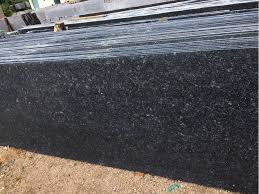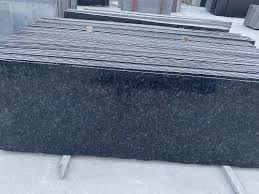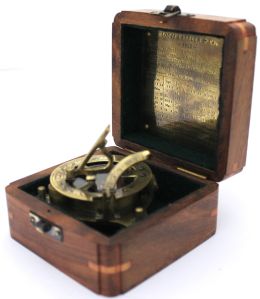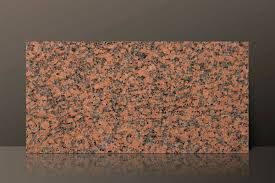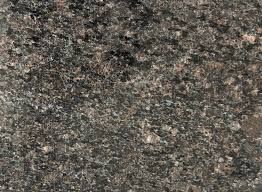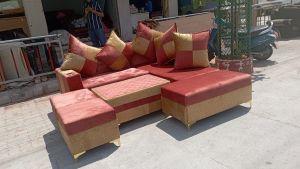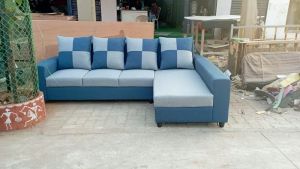- Baopet, Karimnagar, Telangana
- View Mobile Number
| Business Type | Exporter, Supplier, Trader |
| Material | Granite Stone |
| Surface Finishing | Polished |
| Color | Blue |
| Click to view more | |
Preferred Buyer From
| Location | Worldwide |
Product Details
Honey Blue Granite is a visually striking natural stone known for its unique and intricate patterning.
Appearance
- Color Palette: As the name suggests, Honey Blue Granite features a harmonious blend of honey-gold and blue-gray hues. The base color is typically a warm honey or golden tone, interspersed with swirls and veins of blue, gray, and sometimes black.
-Patterns: The granite exhibits a dynamic pattern with intricate veining and mottling. These natural patterns create a sense of depth and movement within the stone, making each slab unique.
-Texture: Honey Blue Granite has a coarse-grained texture that is characteristic of granite. It can be finished in various ways, including polished, honed, or leathered, each enhancing its natural beauty in different ways.
Properties:
- Durability: Granite is known for its durability and resistance to scratches, heat, and general wear and tear, making it an excellent choice for high-traffic areas and surfaces that require frequent cleaning.
- **Maintenance**: This granite requires minimal maintenance. Regular cleaning with mild soap and water is usually sufficient. Periodic sealing can enhance its longevity and maintain its polished look.
- Applications: Due to its aesthetic appeal and durability, Honey Blue Granite is popular for a variety of applications, including kitchen countertops, bathroom vanities, flooring, wall cladding, and outdoor installations such as patios and garden pathways.
Origin and Availability
-Source: Honey Blue Granite is typically quarried in regions known for their rich geological formations, such as parts of India and Brazil. Each quarry may produce slightly different variations in color and pattern, contributing to the uniqueness of each slab.
-Availability: As a natural stone, availability can vary depending on the quarry yield and demand. It is advisable to check with local suppliers for specific availability and to view slabs in person when possible.
Design Considerations
-Complementary Colors: The warm and cool tones of Honey Blue Granite make it versatile for pairing with a wide range of cabinetry, flooring, and wall colors. It works well with both traditional and modern design aesthetics.
-Lighting: Proper lighting can enhance the natural beauty of the granite, highlighting its veining and color variations. Under-cabinet lighting in kitchens, for instance, can accentuate its polished finish and intricate patterns.
Conclusion
Honey Blue Granite is a beautiful and durable natural stone option that brings a unique blend of colors and patterns to any space. Its versatility in design and robust physical properties make it a favored choice for both residential and commercial projects.
When packaging granite, whether it is for slabs, tiles, or smaller pieces, it is crucial to ensure that the packaging protects the stone from damage during transportation and handling. Here are the key details and steps involved in packaging granite:
Packaging Details for Granite
1. Granite Slabs:
Granite slabs are large and heavy, requiring sturdy packaging to prevent breakage and scratches.
- Crates: Use strong wooden crates or A-frames specifically designed to hold the weight and dimensions of granite slabs. These crates often have padded supports to protect the edges and surfaces of the slabs.
- Padding and Protection: Place padding materials such as foam, corrugated cardboard, or plastic sheeting between slabs to prevent them from rubbing against each other. Cover the surfaces with protective film to avoid scratches.
- Securing: Secure the slabs within the crate using straps or braces to prevent movement during transit. Ensure the slabs are tightly packed to minimize shifting.
- Labeling: Clearly label the crates with handling instructions (e.g., "Fragile," "Handle with Care," "This Side Up"), dimensions, and weight information.
2. Granite Tiles:
Granite tiles are smaller but can still be heavy and prone to chipping or cracking if not properly packaged.
- Boxes: Use heavy-duty cardboard boxes for smaller quantities of tiles. For larger quantities, use wooden crates. Ensure the boxes or crates are of appropriate strength to hold the weight.
- Padding: Place foam sheets, bubble wrap, or cardboard dividers between each tile to protect the surfaces and edges from damage.
- Bundling: Group tiles in manageable bundles, wrapping them in plastic or foam for added protection before placing them in boxes or crates.
- Securing: Fill any gaps in the box or crate with additional padding materials to prevent movement. Secure the box or crate with strong packing tape or straps.
- Labeling: Label the packaging with appropriate handling instructions, dimensions, and weight information.
3. Smaller Granite Pieces (e.g., Countertop Edges, Custom Cut Pieces):
Smaller granite pieces require careful packaging to avoid damage.
- Padding: Wrap each piece individually in protective materials such as foam, bubble wrap, or padded paper.
- Boxes or Crates: Place the wrapped pieces in sturdy cardboard boxes or small wooden crates, ensuring there is enough padding around each piece.
- Securing: Fill any empty spaces in the box or crate with additional padding to prevent movement during transit. Use packing tape or straps to secure the packaging.
- Labeling: Clearly label the packaging with handling instructions, dimensions, and weight information.
General Considerations:
- Moisture Protection: Ensure that the packaging materials provide some level of moisture resistance to protect the granite from exposure to water during transit.
- Weight Distribution: When packing multiple pieces in one crate or box, distribute the weight evenly to avoid overloading one side and to make handling easier.
- Transportation Method: Consider the method of transportation (e.g., sea, air, or land) and potential impacts like vibration, compression, or dropping, and adjust the packaging accordingly.
- Inspection: Before shipping, inspect the packaged granite for stability and security to ensure that it is well-protected for its journey.
By following these guidelines, you can help ensure that granite slabs, tiles, and other pieces arrive at their destination in excellent condition, ready for installation or further processing.
When packaging granite, whether it is for slabs, tiles, or smaller pieces, it is crucial to ensure that the packaging protects the stone from damage during transportation and handling. Here are the key details and steps involved in packaging granite:
Packaging Details for Granite
1. Granite Slabs:
Granite slabs are large and heavy, requiring sturdy packaging to prevent breakage and scratches.
- Crates: Use strong wooden crates or A-frames specifically designed to hold the weight and dimensions of granite slabs. These crates often have padded supports to protect the edges and surfaces of the slabs.
- Padding and Protection: Place padding materials such as foam, corrugated cardboard, or plastic sheeting between slabs to prevent them from rubbing against each other. Cover the surfaces with protective film to avoid scratches.
- Securing: Secure the slabs within the crate using straps or braces to prevent movement during transit. Ensure the slabs are tightly packed to minimize shifting.
- Labeling: Clearly label the crates with handling instructions (e.g., "Fragile," "Handle with Care," "This Side Up"), dimensions, and weight information.
2. Granite Tiles:
Granite tiles are smaller but can still be heavy and prone to chipping or cracking if not properly packaged.
- Boxes: Use heavy-duty cardboard boxes for smaller quantities of tiles. For larger quantities, use wooden crates. Ensure the boxes or crates are of appropriate strength to hold the weight.
- Padding: Place foam sheets, bubble wrap, or cardboard dividers between each tile to protect the surfaces and edges from damage.
- Bundling: Group tiles in manageable bundles, wrapping them in plastic or foam for added protection before placing them in boxes or crates.
- Securing: Fill any gaps in the box or crate with additional padding materials to prevent movement. Secure the box or crate with strong packing tape or straps.
- Labeling: Label the packaging with appropriate handling instructions, dimensions, and weight information.
3. Smaller Granite Pieces (e.g., Countertop Edges, Custom Cut Pieces):
Smaller granite pieces require careful packaging to avoid damage.
- Padding:Wrap each piece individually in protective materials such as foam, bubble wrap, or padded paper.
- Boxes or Crates: Place the wrapped pieces in sturdy cardboard boxes or small wooden crates, ensuring there is enough padding around each piece.
- Securing: Fill any empty spaces in the box or crate with additional padding to prevent movement during transit. Use packing tape or straps to secure the packaging.
- Labeling: Clearly label the packaging with handling instructions, dimensions, and weight information.
General Considerations:
- Moisture Protection:Ensure that the packaging materials provide some level of moisture resistance to protect the granite from exposure to water during transit.
- Weight Distribution: When packing multiple pieces in one crate or box, distribute the weight evenly to avoid overloading one side and to make handling easier.
- Transportation Method: Consider the method of transportation (e.g., sea, air, or land) and potential impacts like vibration, compression, or dropping, and adjust the packaging accordingly.
- Inspection: Before shipping, inspect the packaged granite for stability and security to ensure that it is well-protected for its journey.
By following these guidelines, you can help ensure that granite slabs, tiles, and other pieces arrive at their destination in excellent condition, ready for installation or further processing.

